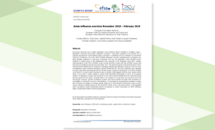Surveillance report: Avian influenza overview November 2018 - February 2019
The “Avian influenza overview” report is published quarterly and provide an update of the developments of avian influenza viruses in EU/EEA and worldwide, in particular with a view to describe the evolution of virus spread from certain regions towards the EU. In case of significant changes in the epidemiology of avian influenza, these reports could be needed more frequently.
The report is published jointly by the European Food Safety Authority (EFSA), the European Centre for Disease Prevention and Control (ECDC) and the European Union Reference Laboratory for Avian influenza (EURL). Avian influenza is an infectious viral disease in birds, including domestic poultry. Avian influenza is mainly found in birds, but under certain circumstances infections can also occur in humans even though the risk is generally very low.
Executive Summary
No human infections due to highly pathogenic avian influenza (HPAI) A(H5N8) or A(H5N6) viruses - detected in wild birds and poultry outbreaks in Europe - have been reported so far and the risk of zoonotic transmission to the general public in Europe is considered very low. Between 16 November 2018 and 15 February 2019, two HPAI A(H5N8) outbreaks in poultry establishments in Bulgaria, two HPAI A(H5N6) outbreaks in wild birds in Denmark and one low pathogenic avian influenza (LPAI) A(H5N3) in captive birds in the Netherlands were reported in the European Union (EU). Genetic characterisation of the HPAI A(H5N6) viruses reveals that they cluster with the A(H5N6) viruses that have been circulating in Europe since December 2017. The wild bird species involved were birds of prey and were likely infected due to hunting or scavenging infected wild waterfowl. However, HPAI virus was not detected in other wild birds during this period. Outside the EU, two HPAI outbreaks were reported in poultry during the reporting period from western Russia. Sequence information on an HPAI A(H5N6) virus found in a common gull in western Russia in October 2018 suggests that the virus clusters within clade 2.3.4.4c and is closely related to viruses that transmitted zoonotically in China. An increasing number of outbreaks in poultry and wild birds in Asia, Africa and the Middle East was observed during the time period for this report. Currently there is no evidence of a new HPAI virus incursion from Asia into Europe. However, passive surveillance systems may not be sensitive enough if the prevalence or case fatality in wild birds is very low. Nevertheless, it is important to encourage and maintain a certain level of passive surveillance in Europe testing single sick or dead wild birds and birds of prey as they may be sensitive sentinel species for the presence of HPAI virus in the environment. A well-targeted active surveillance might complement passive surveillance to collect information on HPAI infectious status of apparently healthy wild bird populations.
Download





